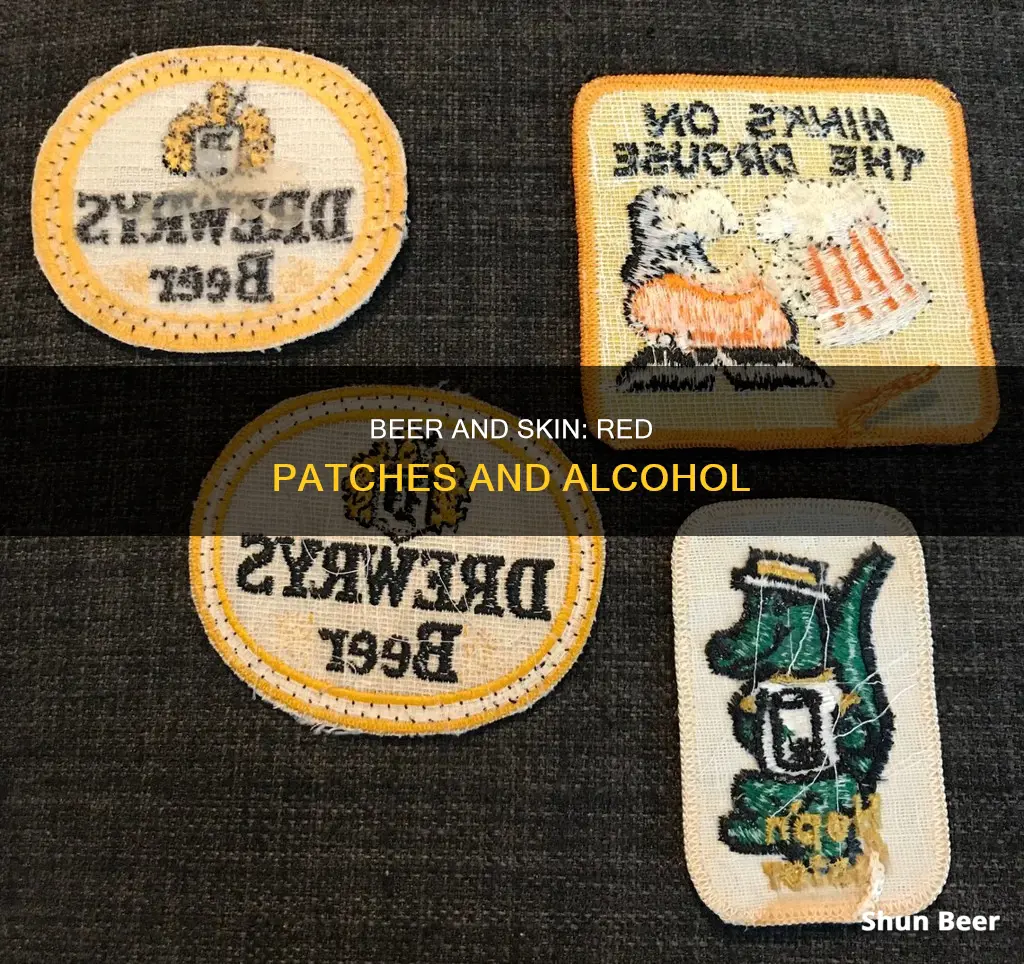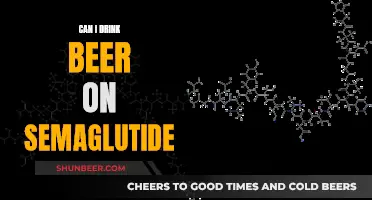
Alcohol flush reaction, commonly known as Asian flush or Asian glow, is a condition where the body is less tolerant of alcohol. This is caused by a genetic variation in the ALDH2 gene, which is responsible for breaking down acetaldehyde, a toxic molecule produced when the body metabolises alcohol. As a result, people with this condition may experience a range of symptoms, including facial flushing or red patches on the skin. While the flushing itself is not harmful, it may indicate a higher risk of serious health issues such as high blood pressure and certain types of cancer. The only way to prevent this reaction is to avoid or limit alcohol consumption.
| Characteristics | Values |
|---|---|
| Reason for red patches | Alcohol flush reaction, a type of alcohol intolerance |
| Cause of alcohol flush reaction | Genetic condition that prevents the body from breaking down alcohol efficiently |
| Prevalence | 8% of the population worldwide |
| Risk factors | Being of Asian or Jewish descent |
| Symptoms | Red face, hives, nausea, low blood pressure, worsening of asthma, migraines |
| Health risks | High blood pressure, cancer (esophageal, breast, throat), heart disease, stroke |
| Prevention | Avoid or limit alcohol intake |
| Treatment | Histamine-2 (H2) blockers, brimonidine, oxymetazoline, lasers and light-based therapies |
What You'll Learn

Alcohol flush reaction
The alcohol flush reaction can cause a range of symptoms, including flushing on the face and body, nausea, headaches, and general physical discomfort. The most obvious symptom is flushing, which can manifest as visible reddening on lighter skin tones or discoloration or darkening on darker skin tones. While the flushing itself is not dangerous, it indicates high alcohol sensitivity and an increased risk of high blood pressure and certain types of cancer, particularly esophageal cancer.
The accumulation of acetaldehyde is believed to be the cause of the alcohol flush reaction. Acetaldehyde is a toxic metabolite of alcohol, and its buildup can trigger a histamine response, leading to the dilation of facial blood vessels and skin discoloration. People with the ALDH2*2 genetic variant are at a higher risk of cancer, especially when combined with frequent alcohol or tobacco use.
The only way to prevent the alcohol flush reaction is to avoid or limit alcohol intake. While some people use over-the-counter antihistamines to reduce the discoloration, this is not advisable as it only hides the symptoms without addressing the underlying cause. It is important to recognize that even people who do not experience the alcohol flush reaction are still at risk of the health complications associated with alcohol use.
Workplace Attire: Beer Shirts, Appropriate or Not?
You may want to see also

Histamine release
Histamine is a chemical produced by the immune system that acts as a defence mechanism against allergens and other harmful substances. When histamine is released in the body, it boosts blood flow to the affected areas. If too much histamine is released, it can cause a range of symptoms, including itching, rashes, redness, and flushed skin. This is known as histamine intolerance.
Histamine intolerance can lead to various skin conditions, including atopic dermatitis (eczema), chronic urticaria (hives), psoriasis, and rosacea. These skin conditions are often treated with creams, ointments, or steroidal medications, which may provide some symptom relief but do not address the underlying cause of the histamine intolerance.
Alcohol consumption can trigger histamine release and lead to skin redness or flushing, especially in individuals with a condition known as alcohol flush reaction. This condition is caused by a faulty version of the aldehyde dehydrogenase 2 (ALDH2) gene, which is responsible for breaking down acetaldehyde, a toxic substance found in alcohol. When the body cannot break down acetaldehyde effectively, it builds up and can cause a histamine response, resulting in flushing and other symptoms.
In addition to alcohol, there are several other factors that can contribute to histamine release and trigger skin conditions. These include drugs, medical conditions, environmental factors, nutritional deficiencies, and diet. Certain foods and drinks, such as smoked meats, legumes, canned or fermented foods, and alcohol, are rich in histamine or contain compounds that promote histamine release.
If you suspect that histamine intolerance may be contributing to your skin condition, it is recommended to adopt a low-histamine diet and consult with a healthcare practitioner to address any underlying medical conditions or nutritional deficiencies.
Drinking Beer on Tel Aviv's Beaches: What's Allowed?
You may want to see also

Alcohol intolerance
The symptoms of alcohol intolerance are the same regardless of the type of alcoholic beverage consumed, be it beer, wine, or hard liquor. In addition to flushing, individuals with alcohol intolerance may experience a rapid heart rate, headache, low blood pressure, hives, a runny nose, and stomach pain. It is important to note that this condition can lead to major health problems, including an increased risk of cancers of the mouth, throat, esophagus, stomach, and liver.
The only way to prevent the uncomfortable reactions caused by alcohol intolerance is to avoid alcohol altogether. While some people may try to treat the symptoms with cold medicines or antihistamines, these medications do not reduce the long-term risks associated with the condition. It is crucial to recognize that alcohol intolerance is a serious matter, and ignoring the symptoms can have severe consequences.
If you experience any symptoms of alcohol intolerance, it is recommended to consult a doctor, especially if you are unsure whether you have an alcohol allergy or intolerance. Doctors may conduct a physical exam and recommend tests, such as skin or blood tests, to determine the cause of the reaction.
Root Beer and Colonoscopy: What's the Safe Call?
You may want to see also

Allergic reaction
Drinking beer can cause red patches on the skin, a condition known as "alcohol flush reaction". This reaction is a type of alcohol intolerance, predominantly caused by genetic variations in certain enzymes that impair the body's ability to metabolise alcohol efficiently. The condition is characterised by a red face or flush, but it can also be accompanied by other symptoms such as hives, nausea, low blood pressure, asthma, and migraines.
The alcohol flush reaction is a result of the body's inability to break down alcohol completely. When alcohol is consumed, the enzyme alcohol dehydrogenase (ADH) converts it into acetaldehyde, a toxic molecule. Normally, another enzyme called aldehyde dehydrogenase (ALDH) metabolises acetaldehyde into non-toxic molecules. However, in individuals with alcohol intolerance, acetaldehyde is not metabolised efficiently, leading to a buildup in the body.
The accumulation of acetaldehyde can cause a histamine release, triggering flushing and other unpleasant symptoms. This histamine response leads to dilation of the facial blood vessels, resulting in skin discolouration. On lighter skin tones, this may manifest as visible reddening, while on darker skin tones, it may cause discolouration or darkening of the affected area.
While the flushing itself is not harmful, it may indicate an increased risk for certain health issues. Studies have linked alcohol flush reaction to a higher likelihood of high blood pressure and specific types of cancer, particularly esophageal cancer. It is worth noting that these risks are associated with the consumption of alcohol itself and not limited to those experiencing the flush reaction.
The only way to prevent alcohol flush reaction is to avoid drinking alcohol or limit alcohol intake. While medications like antihistamines and certain over-the-counter drugs may reduce flushing, they do not address the underlying cause and may even elevate cancer risk by enabling higher alcohol consumption and acetaldehyde production.
Beer Drinking in the Middle Ages: A Medieval Times Guide
You may want to see also

Skin conditions
Alcohol abuse has been linked to several skin conditions, including:
- Acne: Alcohol abuse can cause nutritional deficiencies, which can lead to skin conditions such as acne.
- Rosacea: Alcohol can trigger rosacea flare-ups, causing redness, particularly on the cheeks, nose, chin, and forehead. It may also increase the risk of developing rosacea.
- Psoriasis: Heavy drinking can trigger psoriasis outbreaks, especially in men, and reduce treatment options.
- Cellulitis: Alcohol dehydrates the body and can irritate the stomach lining, leading to a higher risk of cellulitis, a bacterial skin infection.
- Dermatitis: Alcohol can trigger seborrheic dermatitis flare-ups, causing itchy, greasy skin patches.
- Skin Infections: Excessive alcohol consumption can weaken the immune system, leading to an increased risk of skin infections.
- Skin Cancer: Alcohol is associated with an increased risk of skin cancer, including squamous cell carcinoma, basal cell carcinoma, and melanoma.
- Alcohol Flush Reaction: Alcohol can cause facial flushing, particularly in individuals with a specific gene variation, leading to a red face and other symptoms such as hives, nausea, and low blood pressure.
- Generalised Pruritus: Alcohol abuse can lead to a build-up of substances that stimulate nerve endings in the skin, causing generalised skin itching.
- Nail Changes: Alcohol abuse can cause various nail changes, including clubbing, koilonychia, Terry nails, Muehrcke nails, and red lunula.
- Porphyria Cutanea Tarda (PCT): Alcohol is the most common cause of acquired PCT, which results in photosensitivity, skin fragility, blistering, and increased hair growth on sun-exposed areas.
It is important to note that alcohol abuse can have detrimental effects on overall health and well-being, and seeking professional help is recommended if alcohol consumption is causing concern.
Ladies and Beer: Is It a Good Mix?
You may want to see also
Frequently asked questions
Drinking beer or any alcoholic drink can cause facial flushing, which is when the skin on your face turns red. This is due to a build-up of acetaldehyde, a toxic molecule produced when the body breaks down alcohol.
The build-up of acetaldehyde occurs when the body cannot metabolise alcohol effectively. This is often due to a genetic condition where the body doesn't have the proper enzymes to break down the toxins in alcohol.
People of East Asian descent are more likely to experience facial flushing after drinking due to a higher prevalence of a specific gene variation. However, people of other races and ethnicities can also carry this variation.
Yes, facial flushing after drinking is linked to a higher risk of certain types of cancer, particularly esophageal cancer, as well as high blood pressure.







